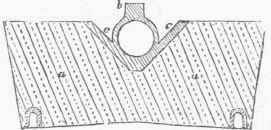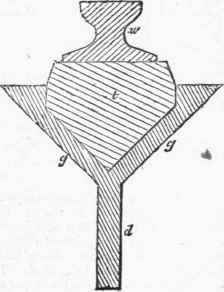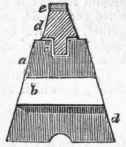Parkins's Petrified Sleepers
Description
This section is from the book "The Engineer's And Mechanic's Encyclopaedia", by Luke Hebert. Also available from Amazon: Engineer's And Mechanic's Encyclopaedia.
Parkins's Petrified Sleepers
Mr.Thomas Parkins, of Dudley, took out a patent for a similiar object to the foregoing, in December 1835. It consists in forming continous sleepers of vitrified earth (burnt clay), which the patentee states are as hard and durable as granite, and impervious to the weather. The following Fig. 1 gives a cross section of Mr. Parkins's railway, and Fig. 2 a side elevation of a portion of it. The vitrified blocks or sleepers are shown at a a a; each sleeper is 13 inches at the base, 5 at the top, 12 deep, and 9 long, and locks into the other, thus forming a continous mass along the whole line of road. The joining is effected by a projecting tongue b, which fits into a corresponding recess made in each block A groove c is moulded longitudinally in the top of the sleepers,into which the rib of a wooden bearer d (four inches at the base, four deep, two wide at the top, and twelve feet or more long) is placed; and is bedded upon patent felt; on this wooden bearer is fixed an iron bar e e, for the wheels of the carriages to run upon; this bar or rail being also bedded upon felt.


Fig.1.

Fig. 2.

Mr. Parkins gives the preference to the arrangement described; but he proposes, in certain cases, to dispense with the wooden bearers d d, and to place iron rails of the ordinary kind at once into the groove c.
Continue to:


